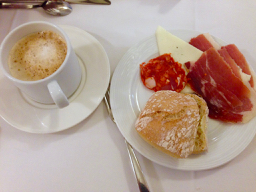Unexpected Segovia
- Francesca Arniotes
- Apr 18, 2019
- 4 min read

Segovia, Spain is a UNESCO World Heritage City. The Alcazar, a royal palace built upon a Moorish fortress built upon the foundations of a Roman fort, rises from an outcropping above two rivers. The medieval tangle of streets winds through the Jewish Quarter, buildings’ facades carved with geometric and plant motifs. The massive gothic cathedral dominates the Plaza Mayor which is alive with eateries and kids dribbling soccer balls even at 1AM.
We came to see the famous two thousand year old Roman aqueduct, towering nearly 100 feet above the plaza, its two tiers of magnificent arches, the Romans’ monumental development in engineering, constructed of granite blocks so carefully cut and stacked they required no mortar. It runs 11 miles from the water source and supplied the city water continuously until the late 1800’s. One evening after dark we turned a corner and saw the aqueduct lit up with colored lights, a backdrop for a community band concert. We found a taverna on the end of the plaza, up some steps and with its patio extending almost to the face of the bridge. We sat there, inches from one of the keystones, listening to music, looking at the stars and enjoying a variety of tapas and rich red wine.
We came also to eat the Cochinillo, whole roast piggie so succulent that it is cut with the side of a dinner plate, announcing its arrival in the dining room with a proud crack that shatters the perfectly crispy skin into mouth-watering bites. We had been tantalized by this delicacy for years, in magazines and travel shows. Only we hadn’t pictured them so little, and that made us too sad. So we only ate it once. However, we were delighted to discover that the city was holding its 11th Concurso de Tapas wherein bars and restaurants compete to win the prize for best tapa. And here we were! For a week!

Traditional tapas protocol is to order a drink and receive a tapa with it. “Tapa” means a “lid”. Probably originating in southwestern Andalusia where the sweet sherry of the area attracted fruit flies, glasses of the wine were served with a thin piece of bread or ham atop each glass to keep them out. The ham worked like peanuts: make more thirst, sell another drink. The bread likely evolved its own toppings because folks in hospitality trades can’t stand to send bread out naked for long. They like to surprise and delight their customers. Add the spirit of competition for attracting those customers and eventually every establishment had its unique tapa. It took some time for the tapas scene to spread throughout the country and predictably, each of Spain’s autonomous communities put its own spin on things. These days, in some places, taverns offer only one signature tapa. In others they are careful to always have a fish, a meat and a “tierra” or “something from the earth”. We were given tapas free with our wine everywhere in Granada, but had to pay for them in Sevilla. In Navarre and in Basque Country where the original tapa was a pickled pepper, a green olive and an anchovy on a toothpick, tapas are called Pintxos, because they use wooden picks of different sizes to keep the various components together. The sizes correspond to the prices of the pintxos and when you are ready to leave, the picks are counted up and the bill calculated.
For the competition in Segovia, each tavern or restaurant creates an imaginative original tapa. During an evening, if you want to sample their special entry you pay for the tapa -- this year 1.70 euro. Usually a brewery sponsors the event, so you can get a bottle of beer to go with the tapa for a total of 2.70 euro. To participate in the voting you have to go to all or a certain number of the participating establishments over the 10 days, and then you may vote and the most votes determines the winner.
In 2014, there were 40 establishments competing. We had a great time each evening sampling offerings that ranged from delicate, exquisitely plated works of art to mini-burgers and fries. What were they like? How about a tiny quail egg set atop a timbale of vegetables, a bouquet of delicate oyster mushrooms sprouting from its side, all sprinkled with ham dust, toasted sesame seeds, onion-infused olive oil and a crackling spinach wafer? Or a mousse of braised lamb and its juices set on a bed of grilled spiced eggplant and crowned with crescent- shaped crisps of potato and ham? An ox-meat slider with goat cheese, and onion caramelized in Ribera del Duero wine, perhaps. Since 2007, the tavern El Fogon Sefardi has won almost every year. We tasted their “Magic-Spell of Basil” creation: a thin bite of buttery hake and one of salmon sandwiching a mixture of spinach and pine nuts, bathed in an emulsion of basil and set atop a round of flaky pastry. These tapas have provided plenty of inspiration for inventing appetizers for our parties. Maybe you’ll get some ideas and start experimenting yourself. If you need some help getting started with how to put flavors and textures together, Castles and Kitchens is happy to guide you. Come play. Or check out the 16th Concurso de Tapas in Segovia for yourself. It starts June 21.



Comments